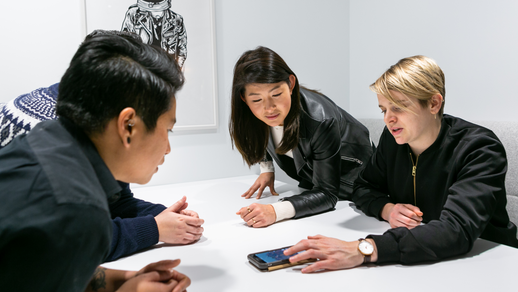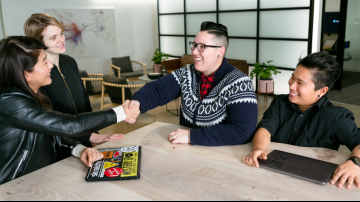There are common beliefs about user experiences—the best ones are user-centered, iterative, and intuitive. When user experience (UX) research is conducted, user stories about these experiences are collected—but the research methods chosen inform user experiences, too.
So, what makes for an engaging research experience, and how can methods evolve alongside products to better connect with users?
Red Hat's User Experience Design (UXD) research team has the answer: a community-centered, open source mindset.
As a UX writer on Red Hat's UXD team, I create new design documentation, empower team voices, and share Red Hat's open source story. My passion lies in using content to connect and inspire others. On our Twitter and Medium channels, we share thought leadership about UX writing, research, development, and design, all to amplify and grow our open source community. This community is at the heart of what we do. So when I learned how the research team centers community throughout their user testing, I leaped at the chance to tell their story.
Approaching research with an open source mindset
Red Hat's UXD team creates in the open, and this ideology applies to their research, too. Thinking the open source way involves adopting a community-first and community-driven frame of mind. New ideas can come from anywhere, and an open source mindset embraces these varied voices and perspectives.
Structuring research with an open source mindset means each research technique should be driven by two angles—we don't just want to learn about our users; we want to learn from them, too.
To satisfy both of these user-focused objectives, we make research decisions backed by other voices, not just our own. By sourcing input from beyond our team, we design research experiences that are truly tailored to the communities we serve.
Guiding questions help us streamline this process. Some questions the team's researchers use to develop their methods include:
- Does this method amplify user voices?
- Are we facilitating open communication with our users?
- Does this method build a meaningful connection with our user base?
- What kind of experience does this technique build? Is it memorable? Engaging?
Notice a trend? Each question hinges on community.
Building research experiences like user experiences
Researchers approach their UX research as a user experience, too. We want our research sessions to have the same qualities as our user interfaces:
- Memorable
- Engaging
- Intuitive
- User-centered
Research offers in-depth engagement with our user base, so it's important to tailor our techniques to that community. When we conduct user research, we learn more about how our users engage with our products and use that knowledge to improve them. We can use that same process to shape future research sessions.
Open source, user-centered research—sounds great. But how can we actually achieve it?
Let's take a look at five collaborative techniques we use to design more immersive user research experiences the open source way.
Evolve research methods to build engaging experiences and strong connections
Tailor research methods to the target audience, with a goal to create a connective experience. The tools at our disposal vary largely depending on our venue (in-person vs. virtual), so this approach lets us get creative.
- Add dimension: Are you conducting a survey? Consider appealing your users' senses offscreen. We've expanded our research to the third dimension using strings, LEGOs, and card diagrams to collect data in more tactile ways.
- Streamline: Are your research methods efficient and time-conscious? There's only one way to find out. Follow up with users about their experience post-session. If they say a survey or form was cumbersome, consider condensing your longer questions into smaller, more digestible ones.
- Simplify: Use what you know about your user base to customize your techniques. A busy community working in enterprise IT, for example, might only have time to fill out a brief form. Structure your methods so that they're navigable and intuitive for your specific audience.
Guide research with research
Contextualize questions around user's needs. Explore their goals. Identify their cares, difficulties, and thoughts on product performance. Use these findings to design more meaningful research sessions, and check in often. As our products evolve with our users, our research methods do, too.
Keep an open mind
Work with the community to disprove our own assumptions. Lean into the spirit of open source by engaging with others across the team, company, user base, and industry. Use these communities like a sounding board for ideas and welcome their feedback. Community-centered conversations take place in environments like:
- Team meetings and brainstorms
- Company calls and research shares
- Conferences and industry panels
- Internal and external blogging platforms
- Other thought leadership forums
This means speaking at monthly meetings, messaging across team channels, and presenting ideas at annual thought leadership events, where a multitude of voices meet from across the industry to share their experience and expertise.
Communicate, communicate, communicate
With an open source mindset comes open communication. Spark meaningful conversations with users and keep those channels open beyond formal research sessions. Community-driven research techniques start with just that: community. Invest in a strong connection with users to invite deeper insights and facilitate more impactful sessions.
Experiment with new research techniques and take a user-centered, UX approach
Prototype. Test. Iterate. Repeat. The methods will morph as the open source approach takes shape.
That's the magic of conducting research in the open: dynamic change, driven by a deeper connection to the community.
Learn more about how Red Hat's UXD team conducts research by checking out DevConf.US, where individuals across the open source community come together to talk all things tech, open source, and UX.









Comments are closed.